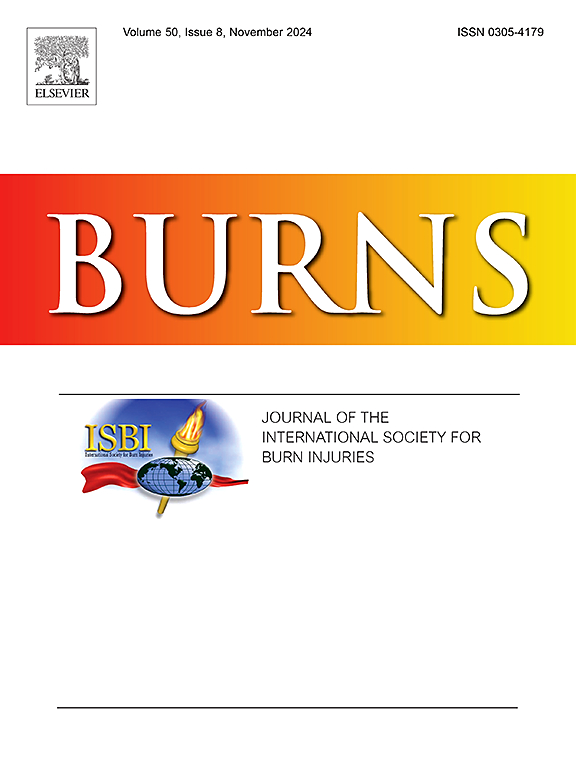缺氧通过p38/MAPK/MAP4通路损害心肌细胞自噬
IF 3.2
3区 医学
Q2 CRITICAL CARE MEDICINE
引用次数: 0
摘要
背景严重烧伤时心肌缺氧可引起严重的心功能障碍,其中自噬通量的阻断起重要作用。既往研究表明p38/MAPK通路通过调控MAP4磷酸化参与调控微管结构,微管结构影响自噬。然而,作为一个复杂的降解过程,自噬如何受到微管的特异性影响尚不清楚。深入了解缺氧相关的自噬障碍对心肌损伤的治疗至关重要。方法从新生儿spraguedawley大鼠脑室中分离心肌细胞(CMs),在1 % O2、5 % CO2和94 % N2的培养箱中培养。利用SB203580和MKK6 (Glu)重组腺病毒分别特异性抑制和激活p38/MAPK通路。利用编码MAP4基因和MAP4 siRNA的腺相关病毒(adeno-associated virus, aav)分别上调和下调MAP4的表达。编码GFP-LC3融合蛋白的AAV感染细胞后,荧光显微镜下绿色斑点的数量表示自噬体的数量。Western blots检测LC3-II、LC3-I和p62的表达。LC3-II与LC3-I的比值(LC3-II/I)反映了自噬体的数量,p62的表达反映了自噬体降解的程度。细胞计数试剂盒8检测细胞活力。使用雷帕霉素恢复自噬。结果缺氧使心肌细胞活力降低,自噬体数量增加,降解减少,p38/MAPK通路被激活。激活p38/MAPK通路可以阻断自噬通路。MAP4的磷酸化不影响自噬体的数量,但会阻碍其降解。p38/MAPK通路可以调控MAP4的磷酸化。最后,当自噬通路恢复后,细胞活力部分恢复。结论缺氧通过p38/MAPK通路调控MAP4的磷酸化,从而阻碍自噬体的降解,而不是数量,阻断自噬通量,最终影响细胞活力。本文章由计算机程序翻译,如有差异,请以英文原文为准。
Hypoxia impairs autophagy of cardiomyocytes via p38/MAPK/MAP4 pathway
Background
Myocardial hypoxia occurs in severe burns and may cause severe cardiac dysfunction, in which the blockage of the autophagy flux plays an important role. Previous studies indicates that the p38/MAPK pathway is involved in regulating the microtubule structure by regulating MAP4 phosphorylation, and the microtubule structure affects the autophagy. However, as a complex degradation process, how autophagy is specifically affected by microtubules remains unknown. An in-depth understanding of hypoxia-related autophagy disorders is critical for the treatment of myocardial injury.
Methods
Cardiomyocytes (CMs) were isolated from the ventricles of neonatal Sprague–Dawley rats and cultured in an incubator filled with 1 % O2, 5 % CO2, and 94 % N2. SB203580 and MKK6 (Glu) recombinant adenovirus were used to specifically inhibit and activate the p38/MAPK pathway, respectively. The adeno-associated viruses (AAVs) encoding MAP4 gene and MAP4 siRNA were used to up-regulate and down-regulate the expression of MAP4, respectively. After infection of cells with AAV encoding GFP-LC3 fusion proteins, the number of green spots under fluorescence microscopy shows the quantity of autophagosomes. Western blots access the expression of LC3-II, LC3-I and p62. The ratio of LC3-II to LC3-I (LC3-II/I) tells the quantity of autophagosomes, and the expression of p62 indicates the extent of autophagosome degradation. Cell Counting Kit 8 was used to detect cell viability. Rapamycin was used to recover the autophagy.
Results
Hypoxia reduced the viability of cardiomyocytes, in which the quantity of autophagosomes is increased, while the degradation is reduced, and the p38/MAPK pathway is activated. Activation of the p38/MAPK pathway could block the autophagy pathway. The phosphorylation of MAP4 did not affect the quantity of autophagosomes, but hindered its degradation. The p38/MAPK pathway could regulate the phosphorylation of MAP4. Finally, when the autophagy pathway was restored, cell viability has partially recovered.
Conclusions
Hypoxia regulates the phosphorylation of MAP4 through the p38/MAPK pathway, thereby hindering the degradation of autophagosomes, rather than the quantity, blocking autophagic flux and ultimately affecting cell viability.
求助全文
通过发布文献求助,成功后即可免费获取论文全文。
去求助
来源期刊

Burns
医学-皮肤病学
CiteScore
4.50
自引率
18.50%
发文量
304
审稿时长
72 days
期刊介绍:
Burns aims to foster the exchange of information among all engaged in preventing and treating the effects of burns. The journal focuses on clinical, scientific and social aspects of these injuries and covers the prevention of the injury, the epidemiology of such injuries and all aspects of treatment including development of new techniques and technologies and verification of existing ones. Regular features include clinical and scientific papers, state of the art reviews and descriptions of burn-care in practice.
Topics covered by Burns include: the effects of smoke on man and animals, their tissues and cells; the responses to and treatment of patients and animals with chemical injuries to the skin; the biological and clinical effects of cold injuries; surgical techniques which are, or may be relevant to the treatment of burned patients during the acute or reconstructive phase following injury; well controlled laboratory studies of the effectiveness of anti-microbial agents on infection and new materials on scarring and healing; inflammatory responses to injury, effectiveness of related agents and other compounds used to modify the physiological and cellular responses to the injury; experimental studies of burns and the outcome of burn wound healing; regenerative medicine concerning the skin.
 求助内容:
求助内容: 应助结果提醒方式:
应助结果提醒方式:


